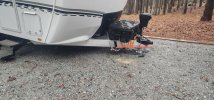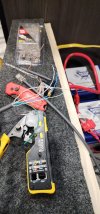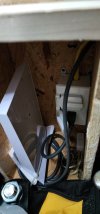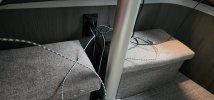Builderdude
Member
- Joined
- Dec 7, 2020
- Messages
- 13
- Reaction score
- 6
- Points
- 3
- Age
- 56
Roger that. Thanks for the help.
Hey, great pics. I have had issues with the truck feeling like the back end is shimmying with the recurve r3 WDH and my TT with 800lb tongue weight. I have the timbrens which made it hard to dial in the recurve. I just upgraded to the cooper AT3 E rated tires (I think my tires were sidewall flexing too much) and bought an anderson hitch. My question to you is, how many turns did you have on your anderson when you had it dialed in (Before the propride)? Thanks.
I had the husky centerline before switching last year to the Anderson. IMHO you don't need to spend any real time on a scale or worrying about it, I certainly didn't. I did get it pretty much level and that's all I need. If you feel you're porpoising too much yet, just stop and take 5 seconds to turn the nut in one more thread. That's the beauty of the system, there is no permanent "set position", every time you hook up you can make adjustments as needed depending on your load (fresh water on board etc).
Trying to make recommendations based on other users descriptions is hard to do. In my case I was trying to reduce vertical bounce in my truck suspension. I tried several times with the husky but it was never as good as the anderson is.
My theory is because the anderson uses chains, whereas the other systems use trunion bars which are (in effect) a second "spring" that can induce or react to other suspension travel in the rear of the truck, and so now you have 2 suspension systems flexing instead of just the truck coils. With the anderson, the hitch itself no longer flexes due to the use of chains, only the coils in the truck flex. This made a huge difference and is better so far than anything else I've tried, including a combination of husky + sumo springs (sumo springs didn't make a difference for my issue, it just looked better visibly but didn't feel better towing)
The only thing I would add, look out for the chains as they travel through the square tubing containing the thread/bolt. Sometimes my chain end gets jammed against the end of the tubing so the bolt feels tight as the "lead" of the chain is wedged in/against the tubing, but the trailer end of the chain is actually quite slack (not visibly) because the bolt is tightened against the beginning of the chain and not the end. Had two sketchy pulls before I figured that out!
Just so you have something to compare to. I have 20 inch michelin defender tires aired up quite high while towing, and also did the hellwig swaybar which I keep on stiffest setting. I wasn't fighting a "shimmy" or horizontal movement so much as a vertical up/down bounce which finally cleared up with the Anderson.
Edit: Also, the amount of turns of the nuts (like you asked for) can't be copied from trailer to trailer, you need to find your own amount of turns. It's dependent on the distance of your coupler to the end of the frame brackets, as well as how heavy your tongue is etc. What works me for me probably won't work for you.
Good summary and tips.
I'll say that I don't agree about the scales. If you're towing often and/or heavy, it's worth the half hour and $20 to make three passes.
Yeah, I get that. But I don't think this dude has been towing with this setup for years.I can see that. For me I know my trailer as I've towed with it for years now, and also just double checked it the first time with tape measure (forget the exact idea there, think its something like half the loaded weight should go back onto the front. So measure front unloaded, measure front loaded, subtract the 2, divide by 2; subtract that value from loaded measurement and that's the target for when chains are connected).
I know when it's "off" now just by how it sits and tows. If my truck and trailer doesn't feel like they're sinking and rising as one more-or-less solidly connected unit then I just turn the nut up a little and carry on. Both the husky and anderson end up at the same measurement with the tape, but the anderson still tows better which I can only think is because of the use of static tension (chains) vs spring tension (trunion bars).
By the end of last season though I was just setting it to 5 or 6 threads depending on carrying fresh water or not. But I had to remove one link in my setup as well.
I was interested in his settings based on the what he went thru to get it dialed in. I dont plan on copying that , but 4 turns is alot different then 2 1/2" so understanding what others ended up with could be helpful. You are right on the distance of the frame brackets, etc but would assume most are generally close if they are set up per directions with the same number of links. The "just get it level" doesnt work with timbrens since I will always be basically level with a load on the back. We are planning to stop at a scale on the way out tomorrow so we will see how much is transferred. Were you able to slide the hitch into the receiver to the second hole or did you use the first pin hole?I had the husky centerline before switching last year to the Anderson. IMHO you don't need to spend any real time on a scale or worrying about it, I certainly didn't. I did get it pretty much level and that's all I need. If you feel you're porpoising too much yet, just stop and take 5 seconds to turn the nut in one more thread. That's the beauty of the system, there is no permanent "set position", every time you hook up you can make adjustments as needed depending on your load (fresh water on board etc).
Trying to make recommendations based on other users descriptions is hard to do. In my case I was trying to reduce vertical bounce in my truck suspension. I tried several times with the husky but it was never as good as the anderson is.
My theory is because the anderson uses chains, whereas the other systems use trunion bars which are (in effect) a second "spring" that can induce or react to other suspension travel in the rear of the truck, and so now you have 2 suspension systems flexing instead of just the truck coils. With the anderson, the hitch itself no longer flexes due to the use of chains, only the coils in the truck flex. This made a huge difference and is better so far than anything else I've tried, including a combination of husky + sumo springs (sumo springs didn't make a difference for my issue, it just looked better visibly but didn't feel better towing)
The only thing I would add, look out for the chains as they travel through the square tubing containing the thread/bolt. Sometimes my chain end gets jammed against the end of the tubing so the bolt feels tight as the "lead" of the chain is wedged in/against the tubing, but the trailer end of the chain is actually quite slack (not visibly) because the bolt is tightened against the beginning of the chain and not the end. Had two sketchy pulls before I figured that out!
Just so you have something to compare to. I have 20 inch michelin defender tires aired up quite high while towing, and also did the hellwig swaybar which I keep on stiffest setting. I wasn't fighting a "shimmy" or horizontal movement so much as a vertical up/down bounce which finally cleared up with the Anderson.
Edit: Also, the amount of turns of the nuts (like you asked for) can't be copied from trailer to trailer, you need to find your own amount of turns. It's dependent on the distance of your coupler to the end of the frame brackets, as well as how heavy your tongue is etc. What works me for me probably won't work for you.
I can tell you the distance between the bottom bolt for the frame bracket and the center of the coupler in mine (red line in picture). It was right at 29".You are right on the distance of the frame brackets, etc but would assume most are generally close if they are set up per directions with the same number of links.

I tried both. Our dealer originally installed it using the first hole. This was kind of nice because I could drop my tailgate. But, it felt pretty unstable. Checking weights at the scales, we were at about 9% tongue weight. Just moving it in to the second hole put us closer to 11% tongue weight and felt a bit better.Were you able to slide the hitch into the receiver to the second hole or did you use the first pin hole?
I was interested in his settings based on the what he went thru to get it dialed in. I dont plan on copying that , but 4 turns is alot different then 2 1/2" so understanding what others ended up with could be helpful. You are right on the distance of the frame brackets, etc but would assume most are generally close if they are set up per directions with the same number of links. The "just get it level" doesnt work with timbrens since I will always be basically level with a load on the back. We are planning to stop at a scale on the way out tomorrow so we will see how much is transferred. Were you able to slide the hitch into the receiver to the second hole or did you use the first pin hole?







I appreciate both you and Silver Billet's input. Started with 7 threads showing and weighed at 3400 front and 3600 back. which was about where I was with the recurve. Cranked it another 1/2 turn before we headed out and it towed well at 63-65 in 10mph winds. Not sure if it is the hitch, the e-rated tires, or both, but it was far from a "white knuckle" event. Thanks again.I can tell you the distance between the bottom bolt for the frame bracket and the center of the coupler in mine (red line in picture). It was right at 29".
View attachment 154135
I tried both. Our dealer originally installed it using the first hole. This was kind of nice because I could drop my tailgate. But, it felt pretty unstable. Checking weights at the scales, we were at about 9% tongue weight. Just moving it in to the second hole put us closer to 11% tongue weight and felt a bit better.
26' and 7,500 lbs.I’m sure you mentioned it before but what size camper is that?
Sent from my iPhone using Tapatalk Pro
There are multiple RV websites that can give pretty good info . If you are looking for a bumper-pull, ask others what they are pulling, but remember, if you are a first timer, keep the length down until you have experience. I started with a 23, and went up to a 34, after many thousands of miles though.Thanks I’m just trying to get a visual for a possible future distant purchase. Seems most rv dealers like to take angled pictures and not a sideview so I can get a idea what size would be a good option. Of course I can go see one in person but I’m not a buyer right now so I rather not deal with sales.
Sent from my iPhone using Tapatalk Pro
There are multiple RV websites that can give pretty good info . If you are looking for a bumper-pull, ask others what they are pulling, but remember, if you are a first timer, keep the length down until you have experience. I started with a 23, and went up to a 34, after many thousands of miles though.
Good luck and stay safeIt wouldn’t be anywhere over 25’ I wouldn’t need anything longer then that. 21-25’ seems like the sweet spot without becoming to much of a hassle to move when the time comes. A 19’ is just seems like a tad bit to small and from my research lack the floor plan and some features I would like. Ive been on and off on buying one for a few years and seems some manufacturers either include tongue length or don’t when it comes to specs so that adds to some confusion. I would be new to travel trailers but i’ve towed equipment from time to time so I have an idea on whats to much for my needs.
Sent from my iPhone using Tapatalk Pro
